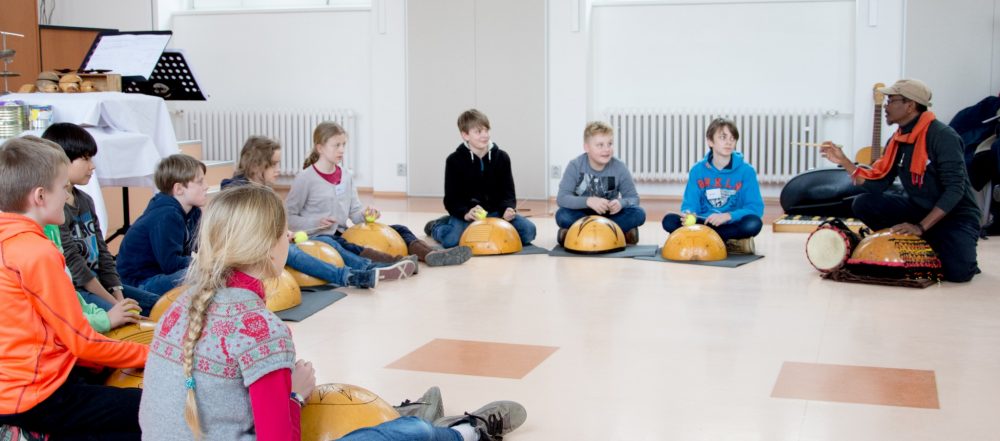Music from Africa…
…is often associated with pulsating rhythms, drums and sparkling energy. A closer look reveals a much more detailed picture. The variety of ethnic groups, languages, geographic areas, and life worlds is reflected in a multi-faceted wealth of music styles, sound colours and instruments.
The different forms of music have derived from practice and not “on the basis of an abstract theory” (Brandily, 2001). For instance, tone systems, rhythmic organisational principles, and musical practice show a great historical consistency in spite of constant changes and continued development (cf. ibid.). A multitude of different influences, such as the migration of different peoples, the colonial period, and media, have created a lively cultural exchange that continues to change and shape music and music practices (Nketia, 1979). In addition, individual artists with their personal styles and creativity play an important role (Kubik, 2004, p.17). Despite all differences, some common general features of African music practice can be identified:
- Oral and auditory traditions: Hearing and listening, rather than writing, are the central tools to teach, learn and remember music.
- Call – response – method: Vocal or instrumental rhythmic patterns and their responses provide the structure of musical sequences. The result is a musical dialogue that structures the music piece in its temporal course. There is no through-composed music, no conductor.
- Rhythm is the fundamental element of music: It develops out of language, movement, and the sensory perception of everyday processes. Pulsation is anchored in the music of Africa in such a way that it takes place naturally (Kubik, 2004). For dancers as well as for musicians, it is a “connecting inner perception of a sequence of the smallest regular pulse units, without beginning and end and without any a priori accentuation” (Ibid.).
- Music and body are in direct correlation. Emotions are expressed through music and dance. The response is verbal or through body movement / dance, which overall results in a mutually influencing interaction.
- Music is a collaborative experience. The circle as a democratic form enables everyone to participate actively. There is no evaluation.
- Traditional instruments and upcycling instruments.
- Improvisation. Rhythms and songs are often strictly defined in their basic structures – however, the play with modified texts, with rhythmic and melodic improvisations is part of the artistic freedom of the musician.
Inspirations from Africa in School
The project music creative + primarily explored the creative potential that unfolds in the encounter with an unknown musical practice. Largely unknown instruments such as pumpkin or water drums (calabashes), string instruments such as Kora and Ngoni open up new sound worlds to pupils and help break away from existing musical patterns. It is less about the precise reproduction of “African style” rhythms and songs, but rather the experience of making music and creating polyrhythmic forms together. The close connection to the creation of music, inspired by everyday circumstances, is presented in the module section “African village”. In this section, the perception of rhythmic phenomena in everyday life plays a particular role for the creative work with instruments and musical rhythm. Meeting with a Senegalese musician was certainly a highlight in the project that significantly influenced pupils’ fascination with this kind of music.
It is not always possible to organise such a cooperation. The films and videos included in the following examples may be viewed as an alternative. The subsequent impulses for making African-inspired music are designed as learning sequences with steps that build on each other, although instructors may select and combine elements of the section individually.
References
- Bender, W. 819859. Sweet Mother – Moderne afrikanische Musik. München: Trickster.
- Billmeier, U., Keita, M. (1999). Traditionelle Rhythmen der Malinké. Engerda: Arun.
- Brandily M. (2001). Kora Kosi – Die Musik Afrikas. Heidelberg: Palmyra Verlag.
- Egger, A., Héma, M. (2007). Die Stimme des Balafon. Hamburg: Schell music.
- Grosléziat, C. (2002). comptines et berceuses du baobab. Paris: Didier Jeunesses.
- Koch,V. (1993). Begegnungen mit afrikanischer Musik. Hannover: Metzler Schulbuchverlag GmbH.
- Konaté, F., Ott, T. (1997). Rhythmen und Lieder aus Guinea. Oldershausen: Institut für Didaktik populärer Musik.
- Kubik, G. (2004). Zum Verstehen afrikanischer Musik. Wien:Lit Verlag.
- Miller Chernoff, J. (1999). Rhythmen der Gemeinschaft. Wuppertal: Peter-Hammer-Verlag.
- Nketia, J. H. (1991) Die Musik Afrikas. Wilhelmshaven: Otto Heinrich Noetzel Verlag.
- Rault, L. (2000). Vom Klang der Welt. München: Frederking &ThalerVerlag.
- Reck, D. (1992). Musik der Welt. Hamburg: Rogner & Bernhard GmbH&Co Verlags KG.
- Schütz,V. (1992). Musik in Schwarzafrika. Arbeitsbuch für den Musikunterricht in den Sekundarstufen. Oldershausen: Institut für Didaktik populärer Musik.
- Stockmann, E. (1987). Musikkulturen in Afrika. Berlin: Verlag Neue Musik.
- Tang, P. (2007). Masters oft the sabar. Philadelphia: Temple university press.
- Bender, W. 819859. Sweet Mother – Moderne afrikanische Musik. München: Trickster.
- Billmeier, U., Keita, M. (1999). Traditionelle Rhythmen der Malinké. Engerda: Arun.
- Brandily M. (2001). Kora Kosi – Die Musik Afrikas. Heidelberg: Palmyra Verlag.
- Egger, A., Héma, M. (2007). Die Stimme des Balafon. Hamburg: Schell music.
- Grosléziat, C. (2002). comptines et berceuses du baobab. Paris: Didier Jeunesses.
- Koch,V. (1993). Begegnungen mit afrikanischer Musik. Hannover: Metzler Schulbuchverlag GmbH.
- Konaté, F., Ott, T. (1997). Rhythmen und Lieder aus Guinea. Oldershausen: Institut für Didaktik populärer Musik.
- Kubik, G. (2004). Zum Verstehen afrikanischer Musik. Wien:Lit Verlag.
- Miller Chernoff, J. (1999). Rhythmen der Gemeinschaft. Wuppertal: Peter-Hammer-Verlag.
- Nketia, J. H. (1991) Die Musik Afrikas. Wilhelmshaven: Otto Heinrich Noetzel Verlag.
- Rault, L. (2000). Vom Klang der Welt. München: Frederking &ThalerVerlag.
- Reck, D. (1992). Musik der Welt. Hamburg: Rogner & Bernhard GmbH&Co Verlags KG.
- Schütz,V. (1992). Musik in Schwarzafrika. Arbeitsbuch für den Musikunterricht in den Sekundarstufen. Oldershausen: Institut für Didaktik populärer Musik.
- Stockmann, E. (1987). Musikkulturen in Afrika. Berlin: Verlag Neue Musik.
- Tang, P. (2007). Masters oft the sabar. Philadelphia: Temple university press.
Module overview
|
